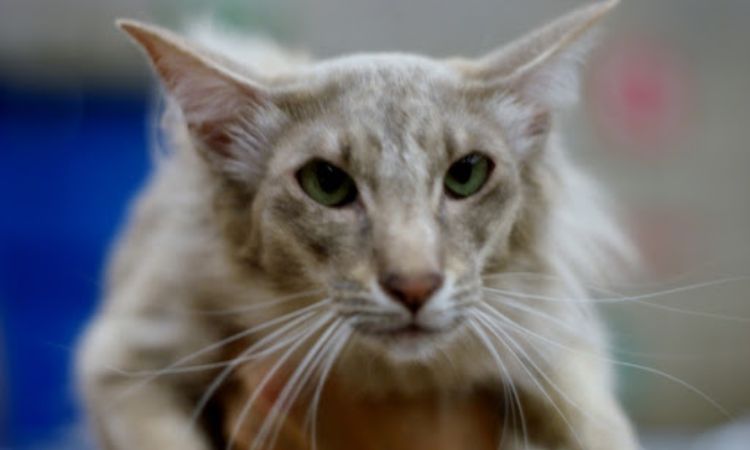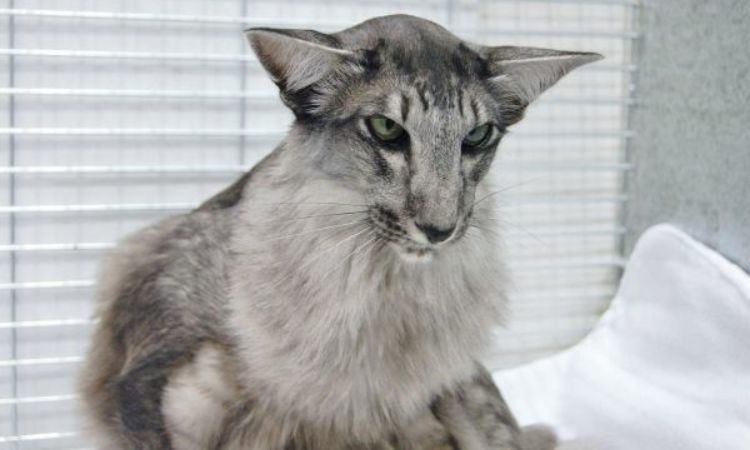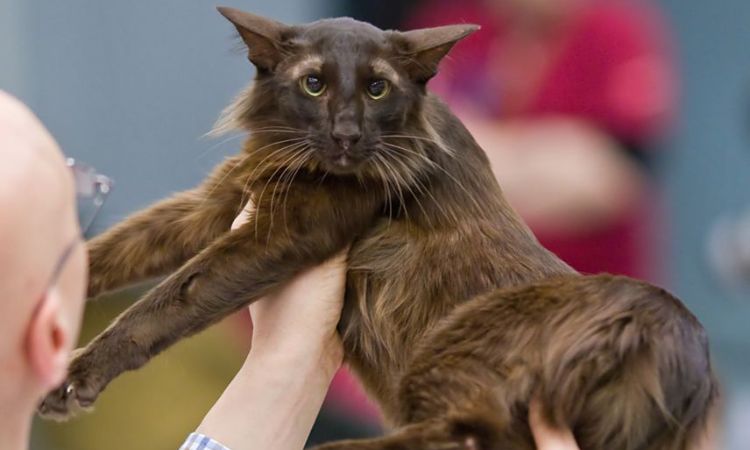With their sleek, elegant bodies and endlessly expressive personalities, Oriental Longhairs are cats that seem to have a story to tell at every turn. Curious, social, and endlessly vocal, these feline companions thrive on interaction, making every day a little livelier for their families.
From their dazzling array of colors to their playful antics, there’s a lot to discover about this captivating breed so let’s dive into everything you need to know about Oriental Longhairs, from personality quirks to care tips and pricing.
Oriental Longhair Personality and Temperament

The “Velcro” Cat: Affection and Companionship
Oriental Longhairs are renowned for their deep attachment to their humans, earning them the nickname “Velcro cats.” They thrive on attention and companionship, often following their favorite people from room to room and wanting to be involved in daily activities. These cats rarely enjoy being left alone for long periods; without interaction, they can become bored or mischievous. Their affectionate nature makes them excellent companions for individuals or families who can provide consistent engagement.
Intelligence and Playfulness
Oriental Longhairs are exceptionally intelligent and curious, traits inherited from their Siamese ancestry. Their mental agility allows them to quickly figure out puzzles, open cabinets, or even learn tricks such as playing fetch. They retain a kitten-like energy throughout their lives, constantly exploring, climbing, and investigating their surroundings. To keep them happy, they require plenty of mental stimulation, including interactive toys, puzzle feeders, and play sessions that mimic hunting behavior.
Vocalization
Like their Siamese relatives, Oriental Longhairs are highly vocal, using a wide array of sounds—meows, chirps, and trills—to communicate their desires and moods. While they can be talkative, their vocalizations are often described as slightly softer and more conversational than the modern Siamese, giving them a charming and expressive personality without being overly loud. They will “chat” with their owners frequently, expressing affection, curiosity, or simply checking in throughout the day.
Compatibility
Oriental Longhairs are friendly and adaptable, making them well-suited to households with children, other cats, or cat-friendly dogs. They thrive in active homes where they can participate in family life and enjoy regular social interaction. Because of their intelligence, energy, and need for engagement, they do best in environments where they are provided companionship, stimulation, and opportunities to play, climb, and explore.
Oriental Longhair Colors and Appearance
Coat Characteristics
The Oriental Longhair’s coat is semi-long, lying flat against the body with a fine, silky texture and a slight undercoat. Unlike Persian or Himalayan cats, the coat does not have a dense, woolly undercoat, which makes it less prone to matting and easier to maintain with regular brushing. The fur on the tail, neck, and legs is slightly longer, adding to the flowing, graceful appearance of the breed.
Despite its length, the coat sheds moderately and generally does not require intensive grooming, though daily brushing is recommended to prevent tangles and maintain its silky sheen.
Color and Pattern Variety
One of the most remarkable aspects of the Oriental Longhair is the sheer diversity of colors and patterns. The breed has been selectively developed to showcase nearly every possible combination, making it one of the most colorful cat breeds in existence.
- Solid Colors: Black, white, blue, chocolate, lilac, cinnamon, caramel, fawn, red, cream, and apricot.
- Tabby Patterns: Classic, mackerel, spotted, or ticked tabby variations.
- Tortoiseshell and Torbie: Tortoiseshell cats with tabby patterns.
- Shaded or Smoke: Cats with darker tips and lighter undercoats, including silver smoke.
- Bicolor and Parti-color: Combinations of white with any other color.
- Pointed Patterns: Cats with contrasting coloration on their ears, face, paws, and tail, inherited from their Siamese ancestry.
With nearly 300 recognized color and pattern variations, there is an Oriental Longhair to suit nearly every aesthetic preference, from subtle, soft tones to bold and striking contrasts.

Distinctive Features
Beyond coat color, Oriental Longhairs are known for their refined physical traits:
- Triangular wedge-shaped head with a long, straight profile
- Almond-shaped, expressive eyes that reflect intelligence and curiosity
- Large, wide-set ears that emphasize alertness
- Slender neck and lithe body with long, slim legs and dainty paws
- Plumed tail that complements the flowing lines of the coat
Their overall appearance is sleek, elegant, and highly athletic, combining beauty with functionality—perfect for a cat that is as active as it is striking.
Oriental Longhair Price and Ownership Costs
Initial Purchase Price
The cost of an Oriental Longhair can vary depending on several factors, including pedigree, location, and whether the cat is intended as a pet or show quality.
- Reputable Breeder: A kitten from a reputable breeder typically costs between $800 and $2,000, depending on the cat’s pedigree, quality, and whether the cat is being sold as a pet or for show purposes. Show-quality cats, which are bred to conform to breed standards, tend to be on the higher end of this range, especially if they come from champion bloodlines.
- Adoption/Rescue: While Oriental Longhairs are a relatively rare breed to find in shelters or rescue organizations, adoption fees for any breed are usually lower than purchasing from a breeder. You might expect to pay between $100 and $300 for an adoption, though finding an Oriental Longhair in need of rescue can be a challenge due to their relatively small population in shelters.
Ongoing Monthly Expenses (Estimate)
Owning an Oriental Longhair involves a few recurring costs that should be considered for long-term care:
- Food: The cost of feeding your Oriental Longhair will depend on the quality of food you choose. A high-quality, protein-rich diet typically costs between $30 to $60 per month. Cats with sensitive stomachs or special dietary needs may incur higher food costs.
- Litter and Supplies: Monthly costs for litter, plus any additional supplies like grooming tools or replacement toys, can range between $15 to $30. Choosing a higher-quality, clumping or silica gel litter may be slightly more expensive, but it also helps in maintaining a cleaner and more odor-free environment.
- Routine Veterinary Care and Preventatives: Routine checkups, vaccinations, flea and tick preventatives, and other health maintenance costs generally add up to $20 to $50 per month. It’s important to factor in the potential for emergency medical expenses, though regular vet visits for a healthy cat will keep costs manageable.
One-Time Setup Costs
When you first bring an Oriental Longhair into your home, there are several one-time expenses for setting up the essentials:
- Litter Box & Scratching Posts/Trees: A sturdy litter box will cost about $20 to $50, and scratching posts or trees are essential for this active breed to prevent damage to furniture. These can range from $30 to $150, depending on size and material.
- Toys: Orientals are playful and curious cats that need plenty of stimulation. Expect to spend around $10 to $30 on toys. Interactive toys, such as puzzle feeders or wand toys, can help keep their minds sharp and active.
- Carrier: A good-quality carrier for trips to the vet or travel will generally cost between $30 to $70, depending on the size and design.
- Initial Vet Visit and Vaccinations: Your first vet visit, including vaccinations and any necessary health checks, will typically cost $100 to $200. It’s important to get your new Oriental Longhair fully vaccinated and checked for any health concerns, especially if adopting from a rescue organization.
Health and Care

Lifespan
The Oriental Longhair typically lives between 10 to 15 years, though with proper care, they can sometimes exceed this range. Their lifespan can be influenced by their overall health, genetics, diet, and how well they are cared for over the years.
Common Health Considerations
While the Oriental Longhair is generally a healthy breed, there are a few hereditary conditions to be aware of, many of which they share with their Siamese relatives. Some of the most common health issues include:
- Progressive Retinal Atrophy (PRA): This is a genetic disorder that causes the degeneration of the retina, leading to vision loss over time. PRA is more common in certain breeds, including the Siamese and Oriental Longhair, and can result in eventual blindness.
- Amyloidosis: This is another genetic condition where an abnormal protein called amyloid builds up in the organs, such as the heart, liver, or kidneys. This can lead to organ dysfunction over time, particularly in older cats.
Due to these potential health risks, regular vet check-ups are essential. Routine visits help detect any early signs of illness, manage health conditions, and ensure that your Oriental Longhair stays in optimal health throughout its life. Your veterinarian will also provide guidance on appropriate vaccinations, parasite prevention, and other aspects of health care.
Exercise and Enrichment
The Oriental Longhair is an active and energetic breed, so it’s crucial to provide them with ample opportunities for exercise and mental stimulation. These cats thrive on interactive play and need to stay engaged with activities that challenge their physical and intellectual abilities.
- Climbing Structures: Oriental Longhairs love to climb, jump, and explore high places. Providing tall cat trees or other climbing structures is essential for their well-being. These will not only help them burn off energy but also provide them with a safe environment to satisfy their natural climbing instincts.
- Interactive Play: Engaging your Oriental Longhair in interactive play, such as fetch or using wand toys, will keep them entertained and allow them to use their natural hunting instincts. These cats are highly curious, so offering them various toys that stimulate their senses is key to preventing boredom.
By fulfilling these physical and mental enrichment needs, you ensure that your Oriental Longhair remains happy, healthy, and well-exercised, leading to a long, fulfilling life by your side.
The Oriental Longhair is a commitment to beauty and activity. This breed’s extraordinary range of colors and a semi-long coat make it a unique visual statement. However, its true essence lies in its personality: an intensely vocal, highly intelligent, and perpetually playful companion. Prospective owners must weigh the upfront price and the cat’s deep need for constant engagement. Ultimately, choosing an O.L.H. means welcoming a devoted, shadow-like partner into your life.






